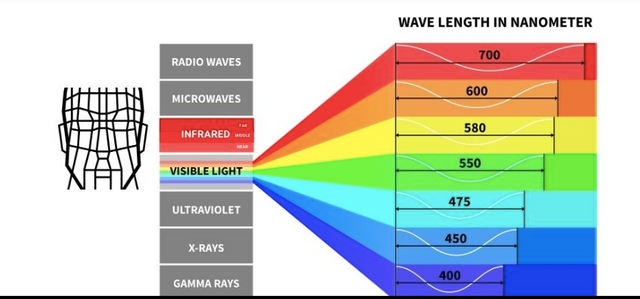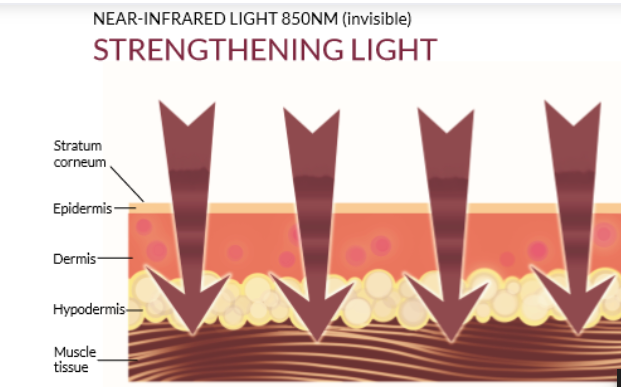RE: Electromagnetic World or Magneto Electric World? What are Ley Lines and what secrets do they hold throughout numerous ancient cultures? Gateways, Portals?
Near Infrared light

Infrared Light (IR) is the light found just past what is visible to the human eye. Near-Infrared Light (NIR) is the section of electromagnetic radiation (EMR) wavelengths nearest to the normal range but just past what we can see.
The basic premise is that long-wavelength lights stimulate cellular energy metabolism and energy production.
Near-infrared (NIR) light therapy is similar to red light therapy, except infrared energy is invisible, and it reaches even deeper into the body — into soft tissues, muscles, joints, and bone. Three major photo acceptor molecules in mammalian tissues are known to absorb light in the NIR range:
hemoglobin, myoglobin, and cytochrome c oxidase.
Of the three, cytochrome c oxidase may be the most important mechanism of photobiomodulation (or low-level laser therapy, LLLT) and is associated with improved cellular energy (ATP) production.


The key characteristic of (near) infrared light is its ability to penetrate not only deep layers of the skin, but also your body’s muscles and other tissues, and even down to the bone.
This can provide faster healing and better pain relief. Infrared light is also incredibly safe, non-invasive, and painless with no known side effects. (It is widely used in the fields of medicine, dentistry, and veterinary medicine.)
That’s why NIR is somewhat of a “magic pill” that may be able to aid in cardiovascular health, pain and inflammation, detoxification, muscular injuries, and more.
Key Benefits:
- Increases ATP production
- Increases antioxidant defenses
- Promotes anti-aging and anti-inflammatory effects
- Helps repair muscle tissues(3)
- Promotes faster bone and wound healing, as well as * pain relief
- Improves thyroid, hormone, and immune function
For healing problems with the back, the use of infrared and red light for pain stimulates healing at the cell and tissular levels in the affected area to reduce inflammation.
https://www.ncbi.nlm.nih.gov/pmc/articles/PMC5364001/
https://www.ncbi.nlm.nih.gov/pmc/articles/PMC6188498/
https://www.ncbi.nlm.nih.gov/pmc/articles/PMC3635110/
https://www.ncbi.nlm.nih.gov/pubmed/28935484
https://www.ncbi.nlm.nih.gov/pmc/articles/PMC4291816/
https://www.ncbi.nlm.nih.gov/pmc/articles/PMC4479368/
https://pubmed.ncbi.nlm.nih.gov/27663159/
One difference between red and infrared light is how the depth their wavelengths penetrate the body. Light appears as different colors according to its wavelength. The human eye can detect wavelengths ranging from about 400 to 700 nanometers (nm), a tiny range when you consider all forms of energy. Red light resides at the end of the spectrum with the longest visible wavelengths. Just beyond that range lies infrared light, which makes it invisible to the human eye.

Since the human eye cannot detect infrared light, on treatment devices with both red and infrared LEDs, you only see the red lights.
Red light works primarily on the skin’s surface, which is one reason for its popularity in beauty and anti-aging applications. Infrared light therapy penetrates deeper into the body, which is how it’s able to treat muscle and nerve pain.
However, the two light sources can complement each other in treating soreness in the body at different depths of tissue.
NASA first used visible red and invisible infrared light technology in a clinical context in the 1990s. From there, scientists learned of its positive effects on other types of living tissue. Infrared waves of light penetrate far beneath the skin into the deep tissue to promote cell regeneration and increase blood flow, thus preventing cell death that causes tissue damage. The results of regular infrared light therapy treatments can include less muscle soreness, fewer spasms, and less stiffness.
Infrared light therapy devices made for home or clinical use are a more recent innovation that can deliver infrared energy to a particular area of the body where nerve pain or muscle stiffness is a problem.
Infrared light treatments for home use are popular with a large audience, from athletes to those with chronic or mild pain. The results are best achieved through regular use.
https://ledtechnologies.com/blog/how-infrared-light-therapy-pain-relief-works/

An article in the journal Photochemistry and Photobiology looked at infrared’s ability to stimulate nerves and support wound healing. That study concluded, “Nerve cells respond particularly well to infrared radiation.”
Red and infrared LEDs produce non-ionizing forms of radiation. This means red and infrared light therapy devices do not pose the same risks as UV light or X-rays. While ionizing radiation contains enough energy to affect the structure of atoms, non-ionizing radiation in LED light therapy treatments does not have that same negative effect.